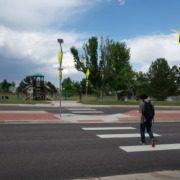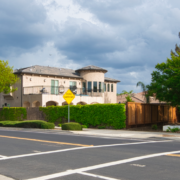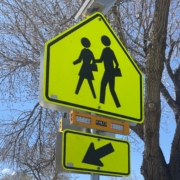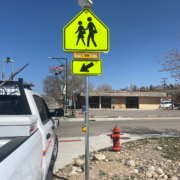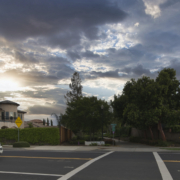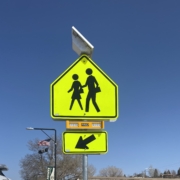Understanding the New Inclusion of RRFB Guidelines in the MUTCD’s 11th Edition
The 11th Edition of the Manual on Uniform Traffic Control Devices (MUTCD), published on December 19, 2023, marks a significant milestone in traffic control and pedestrian safety with the inclusion of Rectangular Rapid Flashing Beacons (RRFBs). This groundbreaking update underscores the commitment to enhancing pedestrian safety across uncontrolled crosswalks.
RRFBs, known for their distinct flashing pattern, have proven effective in increasing driver awareness and yielding behavior, thereby reducing pedestrian-related crashes at uncontrolled marked crosswalks. Their formal recognition in the MUTCD paves the way for broader adoption and represents a major leap forward in improving safety and accessibility for pedestrians.
RRFBs were first introduced as an experimental device in the MUTCD in 2008 and, with the exception of a few months in early 2018 where this status was rescinded due to a patent issue, have remained under an interim approval. With the long-awaited release of the 11th Edition of the MUTCD, the RRFB is now a formal device.
Discover below a brief overview of RRFBs as well as how these beacons have been integrated into the MUTCD’s 11th Edition traffic control guidelines, their design innovations, and operational standards, all of which contribute to a safer and more pedestrian-aware roadway environment.
The Essentials of RRFBs
Rectangular Rapid Flashing Beacons (RRFBs) have been proven to be an extremely effective device for improving safety of pedestrians and cyclists at uncontrolled marked crosswalks. Here is an overview of their design, function, and impact on safety:
Design and Concept
- RRFBs consist of two yellow, rectangular-shaped LED indicators that flash rapidly when activated.
- They are typically post mounted and positioned on both the left-hand and right-hand side of the crosswalk. For typical two-way roadway applications, the RRFB lightbars are usually mounted back-to-back on each pole.
- Suitable for various settings such as crosswalks at uncontrolled intersections, mid-block crosswalks, trail crossings, crosswalks with median islands, and crosswalks at roundabouts.
Functionality
- Activated by pedestrians or cyclists at uncontrolled marked crosswalks.
- Emit intense, rapid flashes, ensuring visibility under various lighting conditions, including bright daylight.
Technology
- The vast majority of RRFBs are solar powered, which enables a cost effective installation as connections to the power grid for each pole are avoided.
- RRFB devices are wirelessly connected to one another, so that when any push button at the crosswalk is pressed all RRFBs will start flashing immediately and stop flashing at the same time.
Safety Impact
- Enhances driver awareness – The distinct flashing pattern stands out, alerting drivers to the presence of crossing pedestrians or cyclists.
- Increases driver compliance – Research indicates RRFBs can increase motorist yielding rates by up to 98%.
- Reduced Crash Rates – Extensive research has proven that RRFBs can reduce pedestrian crashes up to 47%.
- Protects vulnerable road users – Especially effective for ensuring the safety of young, elderly, or disabled pedestrians and cyclists.
MUTCD 11: Chapter 4L Overview
The inclusion of Rectangular Rapid Flashing Beacons (RRFBs) in the Manual on Uniform Traffic Control Devices (MUTCD) 11th Edition, specifically in Chapter 4L, marks a significant advancement in road safety regulations.
Firstly, this inclusion sets a national standard, ensuring uniformity and consistency in the implementation of RRFBs across the United States. Secondly, by formally integrating RRFBs into the MUTCD, it elevates these devices from the interim, experimental status to a recognized tool. This move not only standardizes their use but also encourages wider adoption and adherence to best practices in protecting vulnerable road users.
This chapter of the MUTCD provides comprehensive standards and guidelines for the installation, design, and operation of RRFBs. Here is a summary of its key points:
Application of RRFBs (Section 4L.01)
- RRFBs are specifically for pedestrian-activated and/or bicyclist-activated use at marked crosswalks on uncontrolled approaches.
- RRFBs can be used at crosswalks at roundabouts, and at intersections with two crosswalks on an uncontrolled approach.
Installation Standards
- RRFBs are required to function as a supplement to the following specific signs: W11-2 (Pedestrian), S1-1 (School), or W11-15 (Trail) crossing warning signs.
- RRFBs can be used on an approach in advance to the crosswalk, providing it is supplemental to, and not a replacement for, the RRFBs at the crosswalk itself.
Design Specifications (Section 4L.02)
- Each RRFB unit shall comprise of two rapidly-flashed, rectangular-shaped yellow indications that flash to the specific flash pattern detailed in this section.
- The indications must be at least 5 inches wide and 2 inches high, aligned horizontally with a minimum space of 7 inches between them.
- The placement of RRFB units should be in direct conjunction with the associated crossing warning signs, either on the same support or directly above/below the sign for post-mounted or overhead-mounted signs, respectively.
Operational Standards (Section 4L.03)
- RRFBs must remain normally dark and only activate upon pedestrian actuation, ceasing operation after a predetermined time.
- All associated RRFB units for a given crosswalk must commence and cease their rapid flashing simultaneously.
- The flash rate and sequence are specifically defined to maximize visibility while avoiding frequencies that might induce seizures.
Additional Considerations
- The light intensity of the RRFBs during daytime must meet or exceed the minimum specifications for SAE J595 Class 1 yellow peak luminous intensity.
- To avoid excessive glare during nighttime automatic dimming may be utilized.
Guidance for Enhanced Accessibility
- The use of audible information devices with RRFBs is recommended to assist pedestrians with vision disabilities.
- Small lights directed at pedestrians in the crosswalk may be integrated into the RRFB or pedestrian push button detector for operational confirmation.
This overview of MUTCD 11: Chapter 4L highlights the guidelines and standards set specifically for the implementation of RRFBs. These specifications ensure that RRFBs are used effectively and consistently across various locations, thereby enhancing the safety and visibility of pedestrian and cyclist crossings.
Why Choose Availed Technologies’ AV-400 RRFB?
Availed Technologies’ AV-400 Series RRFB meets and exceeds MUTCD standards and provides industry-leading installation simplicity. The AV-400 is purpose-built exclusively for the RRFB application, and provides numerous features to simplify the installation and reduce installation time and cost. Additionally, the AV-400’s capacity for over 300 daily activations surpasses the typical usage requirements of even busy crosswalks.
The ultra-efficient design of the AV-400 accomplishes this high operating capacity with a compact, lightweight solar engine that is very easy to handle and is small enough to be suitable for installation on standard sign posts. The AV-400 solar engine and lightbars come with universal mounting brackets that readily mount to all pole types.
Availed Technologies’ AV-400 Series RRFBs are designed for efficiency and effectiveness:
- Solar Engine and Battery – 20W high-efficiency monocrystalline solar panel with 45° tilt and 360° rotation, 12V 14-18 Ah AGM sealed lead acid battery.
- Performance – Exceeds MUTCD light output requirements by up to five times, rated for over 300 activations per day.
- Wireless Network – 2.4 GHz wireless mesh, 10 channels, 1000′ range, synchronized activation under 150ms.
- Environmental Tolerance – Operates in -40 to 165° F, battery works in -40 to 140° F, compliant with NEMA TS 2 standards.
- Installation – Quick and simple, with a pre-wired post-top solar engine assembly and a factory-installed universal mounting bracket.
If you are looking for more information on the use and installation of the AV-400 RRFB please visit our FAQ page.
Your MUTCD-Compliant RRFB Solution
The inclusion of RRFBs in the MUTCD’s Chapter 4L is a pivotal moment for road safety, acknowledging their importance in traffic management. This standardization is a major step in unifying safety practices nationwide.
By partnering with Availed Technologies, you’ll benefit from the AV-400 RRFB, an industry-leading product that adheres to MUTCD standards. Start your journey towards safer crosswalks by reaching out to us, and let us collaboratively enhance road safety.


